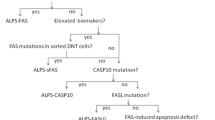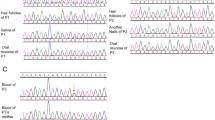Abstract
Autoimmune lymphoproliferative syndrome (ALPS) is a disease of lymphocyte homeostasis caused by FAS-mediated apoptotic pathway dysfunction and is characterized by non-malignant lymphoproliferation with an increased number of TCRαβ+CD4−CD8− double-negative T cells (αβDNTs). Conversely, RAS-associated leukoproliferative disease (RALD), which is caused by gain-of-functional somatic variants in KRAS or NRAS, is considered a group of diseases with a similar course. Herein, we present a 7-year-old Japanese female of RALD harboring NRAS variant that aggressively progressed to juvenile myelomonocytic leukemia (JMML) with increased αβDNTs. She eventually underwent hematopoietic cell transplantation due to acute respiratory distress which was caused by pulmonary infiltration of JMML blasts. In general, αβDNTs have been remarkably increased in ALPS; however, FAS pathway gene abnormalities were not observed in this case. This case with RALD had repeated shock/pre-shock episodes as the condition progressed. This shock was thought to be caused by the presence of a high number of αβDNTs. The αβDNTs observed in this case revealed high CCR4, CCR6, and CD45RO expressions, which were similar to Th17. These increased Th17-like αβDNTs have triggered the inflammation, resulting in the pathogenesis of shock, because Th17 secretes pro-inflammatory cytokines such as interleukin (IL)-17A and granulocyte-macrophage colony-stimulating factor. The presence of IL-17A-secreting αβDNTs has been reported in systemic lupus erythematosus (SLE) and Sjögren’s syndrome. The present case is complicated with SLE, suggesting the involvement of Th17-like αβDNTs in the disease pathogenesis. Examining the characteristics of αβDNTs in RALD, JMML, and ALPS may reveal the pathologies in these cases.


Similar content being viewed by others
Data Availability
All the data and material included in this work have been collected after signed informed consent by all the patients/patients’ relatives.
References
Oliveira JB, Bleesing JJ, Dianzani U, Fleisher TA, Jaffe ES, Lenardo MJ, et al. Revised diagnostic criteria and classification for the autoimmune lymphoproliferative syndrome (ALPS): report from the 2009 NIH International Workshop. Blood. 2010;116(14):e35–40.
Oliveira JB, Bidère N, Niemela JE, Zheng L, Sakai K, Nix CP, et al. NRAS mutation causes a human autoimmune lymphoproliferative syndrome. Proc Natl Acad Sci U S A. 2007;104(21):8953–8.
Takagi M, Shinoda K, Piao J, Mitsuiki N, Takagi M, Matsuda K, et al. Autoimmune lymphoproliferative syndrome-like disease with somatic KRAS mutation. Blood. 2011;117(10):2887–90.
Takagi M, Piao J, Lin L, Kawaguchi H, Imai C, Ogawa A, et al. Autoimmunity and persistent RAS-mutated clones long after the spontaneous regression of JMML. Leukemia. 2013;27(9):1926–8.
Shiota M, Yang X, Kubokawa M, Morishima T, Tanaka K, Mikami M, et al. Somatic mosaicism for a NRAS mutation associates with disparate clinical features in RAS-associated leukoproliferative disease: a report of two cases. J Clin Immunol. 2015;35(5):454–8.
Lubberts E. The IL-23-IL-17 axis in inflammatory arthritis. Nat Rev Rheumatol. 2015;11(7):415–29.
Ivanov II, McKenzie BS, Zhou L, Tadokoro CE, Lepelley A, Lafaille JJ, et al. The orphan nuclear receptor RORgammat directs the differentiation program of proinflammatory IL-17+ T helper cells. Cell. 2006;126(6):1121–33.
Evans CM, Jenner RG. Transcription factor interplay in T helper cell differentiation. Brief Funct Genomics. 2013;12(6):499–511.
Ohga S, Nomura A, Takahata Y, Ihara K, Takada H, Wakiguchi H. Dominant expression of interleukin 10 but not interferon gamma in CD4(-)CD8(-)alphabetaT cells of autoimmune lymphoproliferative syndrome. Br J Haematol. 2002;119(2):535–8.
Cowley SC, Meierovics AI, Frelinger JA, Iwakura Y, Elkins KL. Lung CD4-CD8- double-negative T cells are prominent producers of IL-17A and IFN-gamma during primary respiratory murine infection with Francisella tularensis live vaccine strain. J Immunol. 2010;184(10):5791–801.
Crispín JC, Oukka M, Bayliss G, Cohen RA, Van Beek CA, Stillman IE, et al. Expanded double negative T cells in cases with systemic lupus erythematosus produce IL-17 and infiltrate the kidneys. J Immunol. 2008;181(12):8761–6.
Alunno A, Bistoni O, Bartoloni Bocci E, Caterbi S, Bigerna B, Pucciarini A. IL-17-producing double- negative T cells are expanded in the peripheral blood, infiltrate the salivary gland and are partially resistant to corticosteroid therapy in cases with Sjögren’s syndrome. Reumatismo. 2013;65(4):192–8.
Acknowledgements
We thank Mayuko Miyake for her excellent assistance for the analysis of surface markers.
Funding
This work has been supported by basic research funds distributed annually by the university.
Author information
Authors and Affiliations
Contributions
T.O., H.K., and S.I. designed the research. D.K., T.O., N.S., and H.K. analyzed and interpreted data and wrote the manuscript. T.O., A.M., N.S., and H.K. performed flow cytometry analysis. D.K. and N.S. prepared the figures. M.T., Y.S., K.S., M.T., S.H., K.N., N.S., N.K., and S.I. treated the case; all authors contributed to the final version of the manuscript.
Corresponding author
Ethics declarations
Ethics Approval
The study was approved by the Ethics Committee of the Yokohama City University Graduate School of Medicine (number: B160804004).
Consent to Participate
All the patients and relatives.
Consent for Publication
All the patients and relatives.
Conflict of Interest
The authors declare no competing interests.
Additional information
Publisher’s Note
Springer Nature remains neutral with regard to jurisdictional claims in published maps and institutional affiliations.
Supplementary Information
Rights and permissions
Springer Nature or its licensor (e.g. a society or other partner) holds exclusive rights to this article under a publishing agreement with the author(s) or other rightsholder(s); author self-archiving of the accepted manuscript version of this article is solely governed by the terms of such publishing agreement and applicable law.
About this article
Cite this article
Kurita, D., Shiba, N., Ohya, T. et al. Severe RAS-Associated Lymphoproliferative Disease Case with Increasing αβ Double-Negative T Cells with Atypical Features. J Clin Immunol 43, 1992–1996 (2023). https://doi.org/10.1007/s10875-023-01566-9
Received:
Accepted:
Published:
Issue Date:
DOI: https://doi.org/10.1007/s10875-023-01566-9




